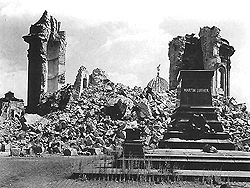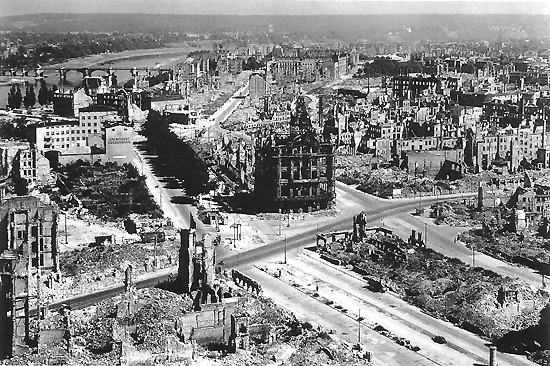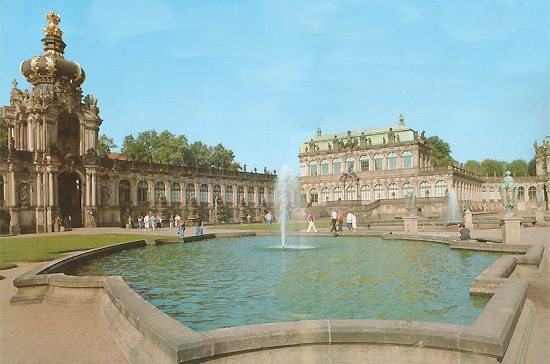Writing Samples – Web Articles
Dresden – A City Reborn
In April 2004, the last sandstone block was lifted and fitted to restore the grand design of the Frauenkirche (Church of the Lady) in Dresden. Completely destroyed in 1945 and left as a ruin monument for the last 50 years, the church’s huge dome now rises again above the city’s famous skyline (ruin and new church below).


After two events of destruction within fifty years—fascist war and socialist dogma—the scarred German city regains its charm, its historical identity. The “Florence on the river Elbe” greets the new millennium in grand old style and proudly reinstates its reputation as one of Europe’s foremost cultural centers.
A proud native of Dresden, I closely watch my hometown’s second rebirth. Every visit to the streets I walked for 20 years reveals a recently finished building, a freshly sandblasted and painted street block, or another celebrated opening of a historical landmark.

Two massive bombing raids in February of 1945 leveled most of the inner city (picture above), including Dresden’s magnificent baroque skyline above the river (picture below).

After mountains of rubble (an estimated 18 million square meters) were cleared and reconstruction projects partially finished in the 1970s, Dresden’s remaining, famous architecture almost fell victim to the socialist economy crisis and property doctrine.
More than forty years after the war, formerly grand churches and palaces still stood in ruins. The once majestic residential buildings in older parts of the city lined up in gray, sad rows of crumbling facades under damaged roofs. Forty years behind the Iron Curtain had also closed Dresden’s gates to tourism and cultural exchange. The world slowly forgot about the treasures along the Elbe.
The city’s destiny changed overnight in November 1989 when a peaceful revolution ended the era of communist party control. The West German government promised to clean up the mess, rescue significant German heritage, and bring prosperity to the former East Germany. Since Germany’s unification, Dresden, as Saxony’s state capital, has received special attention and substantial funding to complete the reconstruction of destroyed or neglected historical buildings and run-down residential areas.
In 2006, Dresden will celebrate 800 years of turbulent history. The city’s facade will proudly present a restored, magnificent anniversary dress. Dresden’s natives and guests from around the world will marvel at the unique baroque ensemble lining both shores of the Elbe, including the Palace, the Court Church, the Semper Opera House, the Frauenkirche, and various royal residences.
 Dresden’s royal history began in 1319, when Dresden came into possession of the Saxon princes and dukes of the House of Wettin. In the 16th century, The Wettiner began transforming the settlement into an electoral residence. August the Strong (1670-1733), King of Poland and Archduke of Saxony, is credited with legendary influence on Dresden’s cultural celebrity. His genius and insatiable passion for building and art was the foundation of the famous baroque architecture throughout the inner city and many palaces in the vicinity of Dresden, as well as the renowned art collections housed within them.
Dresden’s royal history began in 1319, when Dresden came into possession of the Saxon princes and dukes of the House of Wettin. In the 16th century, The Wettiner began transforming the settlement into an electoral residence. August the Strong (1670-1733), King of Poland and Archduke of Saxony, is credited with legendary influence on Dresden’s cultural celebrity. His genius and insatiable passion for building and art was the foundation of the famous baroque architecture throughout the inner city and many palaces in the vicinity of Dresden, as well as the renowned art collections housed within them.
The Royal Palace (picture right), completely bombed out and burned down in 1945, has been painstakingly restored to original splendor after trees had grown tall in its ruins. The palace now houses most of Dresden’s famous art collections, like the art galleries of new and old masters and the treasury, Gruenes Gewoelbe (Green Vault). The grand hall, the last part to be restored, matches the famous mirror hall at Versailles in size and splendor.
The Zwinger has become a symbol of Dresden (picture below). Originally built between 1711 and 1728, the large courtyard was formally used for festivals and grand parties. The Bell Pavilion dominating the southeastern part, charms visitors with the pure sounds of 40 Meissen porcelain bells. The Crown Gate (left), open on all four sides, supports a curvaceous dome topped by the royal crown of Poland, a tribute to August the Strong. The buildings today house collections of clocks, porcelain, mathematical instruments, and art.

 The Semper Opera House (picture right) is one of the most dazzling edifices built for the performing arts. Its grand red and golden interior features sculptures and intricate frescoes and chandeliers, all restored authentically in the 1970s using original plans from 1838. The building is home to one of the world’s most famous orchestras and invites famed stars to perform in operas and ballets each season.
The Semper Opera House (picture right) is one of the most dazzling edifices built for the performing arts. Its grand red and golden interior features sculptures and intricate frescoes and chandeliers, all restored authentically in the 1970s using original plans from 1838. The building is home to one of the world’s most famous orchestras and invites famed stars to perform in operas and ballets each season.
The Frauenkirche will officially open the doors in October 2005 and its enormous dome will again touch the skies and echo the voices of visitors from around the world. On June 22, 2004, the copper crown and iron cross was lifted onto the cupola, finishing the exterior of the church. An uplifting event, especially for all who love this splendid city!